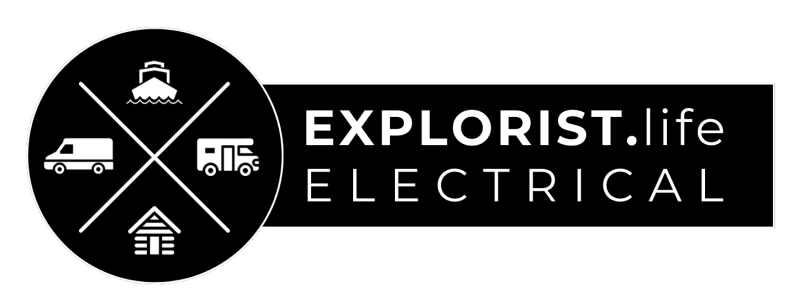
I’ve spent the last 5 lessons of this academy teaching you everything to know about wire size, wire insulation, wire ampacity, common mistakes and more… and now it’s time to tie all of that information together and teach you step-by-step how to choose wire sizes.
For this lesson, I’m breaking down my process for choosing wire sizes into three categories:
- How to size wires for components
- How to size wires for small DC loads like lights, fans, etc.
- How to size wires for 120v outlets.

How to Choose Wire Sizes – VIDEO

How to Size Wires for Components?
When I’m sizing wires for components like inverters, charge controllers, or other similar devices, here is the ‘mental flow chart’ that I use to guide my decision-making process as these are usually larger amperage devices, and I’m just going to walk you through it:

Does the manufacturer make a specific wire size recommendation?
This one is pretty self-explanatory. If you look in the user manual of the device, does the manufacturer recommend a specific wire size? For example; the Victron Multiplus 2000 12V Inverter/Charger user manual recommends 70mm^2 wire for circuits shorter than 5M. (Graphic: 70mm^2 = 2/0 & 5m = 16feet)

Once I have a manufacturer recommendation; I’m always going to plug that into the EXPLORIST.life wire size calculator to double check.

With a bit of rounding:
- 2000W/12V=166A.
- Operating at 12V
- Circuit length of 15 ft
- Default of 3% voltage drop
Recommends 1 AWG wire; which is smaller than the manufacturer’s recommendation. This tells me that the manufacturer has likely sized up their wire for various reasons including decreasing voltage drop and DC ripple but ultimately: if the wire size recommended by the manufacturer is larger than what is calculated; I’m going to use the manufacturer’s recommendation.
What if the calculated wire size is LARGER than the manufacturer’s recommendation?
If our wire size calculator recommends a larger size than the manufacturer; this is a huge red flag to me. Historically, this points to a component that is of low quality and/or a poorly translated manual resulting in errors.
If this is the case, proceed with extreme caution, reach out to the manufacturer for clarification, or reach out to a trained professional for guidance and be prepared to potentially not use that component.
What if the user manual of the device does NOT make a specific wire size recommendation?
If the user manual does NOT make a recommendation OR the user manual makes a recommendation I suspect to be incorrect, my path forward is the same:
I’m going to figure out if the wire terminal is a stud terminal that accepts a wire lug, or if it’s a screw terminal that accepts just a stripped end of wire.
Stud terminals are usually a lot more flexible here because a screw terminal has a finite size of wire that will fit inside.
No Recommendation + Stud Terminal
If it’s a stud terminal; I’m going to do two things:
First: I’m going to use the EXPLORIST.life wire size calculator for my base line.
For this example; I looked up a fairly random 2000W Inverter on Amazon and could not find a recommended wire size. I actually couldn’t even find a user manual posted online.
So; I’m going to take what I know and put it into the calculator:
- 2000W/12V=166A.
- Operating at 12V
- Circuit length of 10 ft (5ft positive & 5ft of negative)
- Default of 3% voltage drop
And this gives me 2AWG.
From there; to double check my work; I would cross-compare this result to a different component of high quality to see if the wire size checks out.
For this; I’ll refer back to the Victron Multiplus 2k from earlier, which recommends 2/0 wire.
From there; I’m just going to use the larger of those two wire sizes between the calculated 2 AWG and the comparative component of 2/0. For this component… I’d use 2/0 wire.
No Recommendation + Screw Terminal
If it’s a component with Screw Terminals, like the Victron SmartSolar MPPT 150-100 for example: the user manual does NOT make a specific wire size recommendation, so we will use the EXPLORIST.life wire size calculator for our baseline.
- This is a 100A charge controller
- Operating at 12V
- Circuit length of 10 ft (5ft positive & 5ft of negative)
- Default of 3% voltage drop
This gives me a result of 4 AWG.

Next, I’m going to cross-reference this wire size with a high-quality component of similar amperage and for this example; I’ve pulled up the user manual for the Outback Power Flexmax 100A charge controller; which is giving a minimum recommended wire size of 4 AWG.

This validation gives me the chance to move forward with at least 4 AWG.
Next, I need to find out if 4 AWG will actually fit into the screw terminal of the SmartSolar MPPT 150|100. The product datasheet for the component tells me the maximum wire size that will fit into the terminal; which is 2 AWG.

Since 2 AWG is larger than 4 AWG, I’m going to bump up from the recommended 4 AWG to the max terminal size of 2 AWG for the sake of further reducing voltage drop and ensuring it will work across all applications.
What if the recommended wire size doesn’t fit into the wire terminal?
This is a red flag for me, and I’m going to look into this with a more critical eye and potentially raise my voltage drop threshold, but I’d also be quite prepared to abandon my idea of using the product.
If the wire terminal size is inadequate to handle the power the component uses or supplies; I have to wonder about the quality of the component.
I could not find a specific example of a component where this were the case; but I have stumbled across that in the past when I was offering a custom wiring diagram service and somebody would provide a bunch of no-name parts from who-knows-where across the internet; but those types of component brands tend to not last very long and the one I had in mind looks like it has gone out of business. Surprise surprise.
How to size wire for small DC loads like lights, fans, fridges, etc.
It’s rare that manufacturers of small devices like lights, fans, fridges make recommendations on wire size; and wire size choice for these small loads is admittedly not as critical as larger devices like inverter, charge controllers, DC DC chargers and such; so for this section; we are going to lean HEAVILY into the EXPLORIST.life wire size calculator.
Two quick examples here:
A maxxair fan operates on high at about 5 amps and 12V. From our fuse block to the fan is 10 linear feet, which would be 10 feet of positive and 10 feet of negative wire; for a total of 20 feet of current carrying wire length.
At 3% voltage drop, the calculator recommends 14 AWG wire, so we can use 14 AWG wire for this circuit.

If we had 10 led puck lights on a circuit, each operating at 0.3A; this would be a 3 amp circuit, at 12V, and let’s say it was 25 feet from the fuse block to the furthest light in the circuit. This would be 25 feet of positive and 25 feet of negative for 50 total feet of current carrying wire length.
At 3% voltage drop, the calculator recommends 12 AWG wire, so we can use 12 AWG wire for this circuit.

What If you want to consolidate wire sizes?
You’ll notice that we had a result of 12 AWG and 14 AWG wire. If you wanted to consolidate wire sizes and just run 12 AWG (which, as a reminder, is the bigger of the two sizes) for both of those circuits; that’s totally fine. The main thing to watch out for is to make sure that whatever wire size you use will fit into the terminal for whatever device you are using or whatever fuse block you are attaching to. This is typically not an issue until you get to wire sizes larger than 10 AWG.
Can I use SMALLER wire?
Sometimes, yes. But this is a more advanced technique and requires a crash course in Voltage Drop.
Voltage Drop is caused by resistance in a wire. Long wire lengths and high amperages cause voltage drop. The resistance of a long wire length or a high amperage load can cause the voltage to drop a bit over the course of the circuit, delivering lower voltage to the device.
So, for our puck light example from earlier; if our battery bank was ACTUALLY putting out 13.6V, and we knew that our puck lights could operate in a ‘range’ of voltages from 10V to 15V. We could actually tell our calculator to allow for 10% voltage drop. 13.6V battery bank voltage x 10% = 12.24V; which is well within our allowable voltage range for the device which allows us to downsize our wire to 16 AWG.
Since 16 AWG wire with 105-degree insulation is rated to 25A before any derating factors, we are well within our limits here.

How do I size wire for 120V loads?
120V loads may be standard household outlets, shore power inlets, or hard-wired air conditioners; and these are easy to size.
If it’s a 50A load; use 6 AWG Wire.
If it’s a 30A load; use 10 AWG Wire.
If it’s a 20A load OR multiple 15A Outlets, and yes, a duplex outlet counts as multiple 15A outlets; use 12 AWG wire.

What about derating factors?
Now, we spent all of lesson 3.4 of this academy on ampacity derating factors, but honestly, in mobile, marine, and smaller off-grid electrical systems, we typically don’t run into those limits because of the small size of systems, limited number of circuits, and shorter lengths of wires; but that is still worth giving a quick glance over to make sure you’re still within safe limits and all of that was covered in a dedicated video.
Conclusion
I hope this helps provide some insight into how I personally size wire for systems I design here at explorist.life
Now; it IS worth mentioning that the DIY system kits and diagrams we sell in our store over at shop.explorist.life have all of the proper wire sizes and types included or figured out for you. 😉
We are going to be referring to wire sizes and types throughout the rest of this academy, so be sure to bookmark this lesson for future reference and come back to it if you need a refresher.
Now that you know everything there is to know about wire sizes and types, it’s time to move on to the next chapter of this academy where we ACTUALLY start putting hands-on tools and I’m going to teach you everything you need to know about cutting, crimping, stripping, and heat shrinking ferrules, wire lugs, PV connectors and much more onto wires and the proper tools to do it with.
